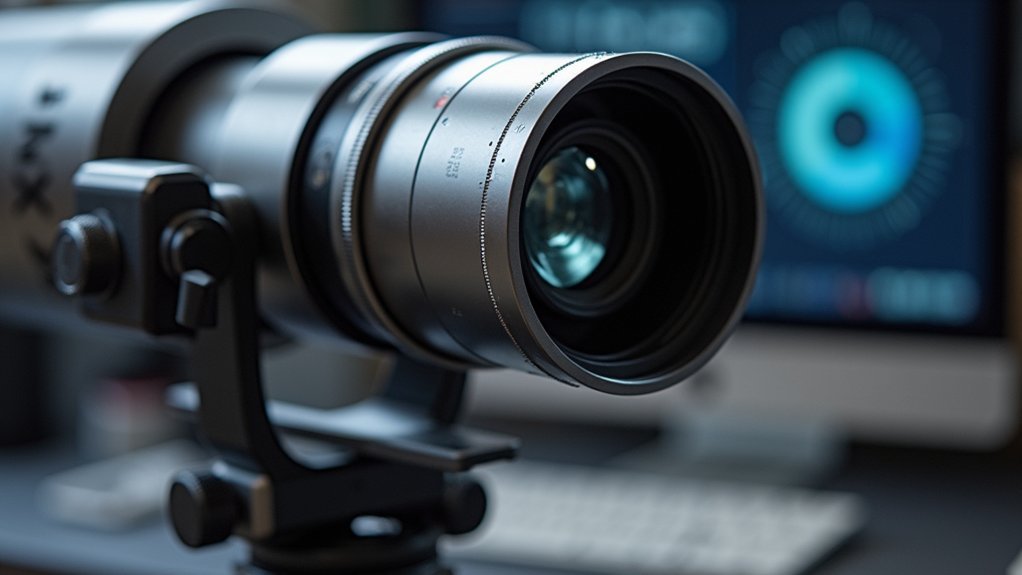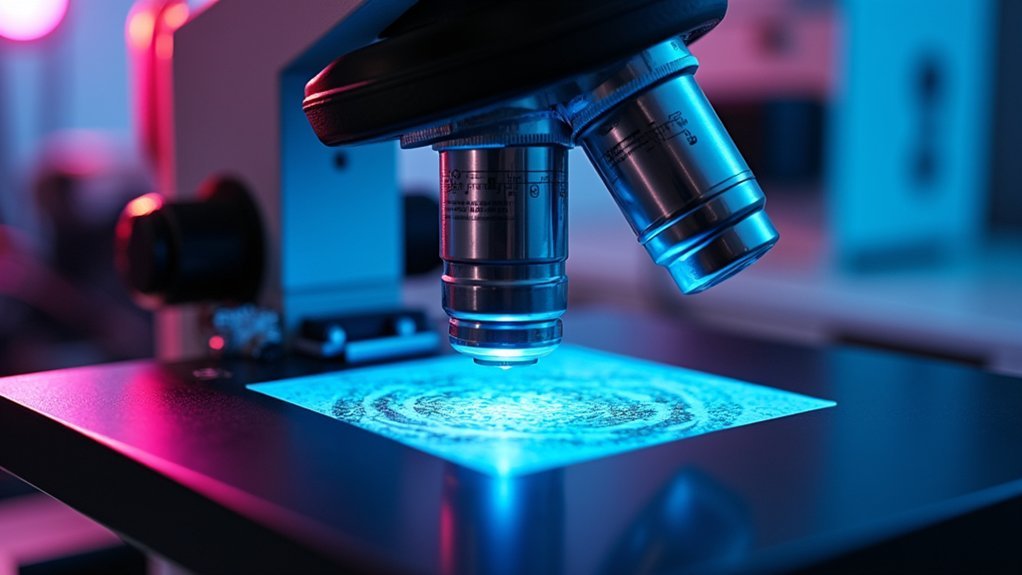To prevent focus drift during imaging, you’ll need to: 1) install anti-vibration tables, 2) maintain stable temperature (20-25°C), 3) use secure clamping mechanisms, 4) implement autofocus algorithms, 5) select low thermal expansion materials, 6) utilize software-based drift compensation, and 7) regularly calibrate your equipment. These techniques work together to minimize mechanical disturbances and environmental fluctuations that compromise image quality. The following strategies will transform your imaging stability for more reliable long-term results.
7 Ways to Prevent Focus Drift During Imaging

While capturing high-quality images requires perfect focus, maintaining that focus throughout an imaging session can be challenging. To combat focus drift, implement an autofocus system that provides real-time adjustments during your imaging sessions.
Focus precision isn’t a one-time achievement—it’s an ongoing battle requiring active countermeasures throughout your imaging session.
Control your environment by stabilizing temperature and humidity, as fluctuations can alter optical components and compromise focus stability. Install an anti-vibration table to minimize mechanical disturbances that contribute to focus drift.
Don’t overlook the importance of regular equipment calibration to guarantee your optical paths remain clean and properly aligned. For precise control, consider using piezoelectric stages that allow you to make quick, minute adjustments when focus drift occurs.
These preventative measures will help you maintain clarity and accuracy in your imaging results, regardless of session duration.
Hardware Stabilization Systems for Continuous Focus
Because focus drift can derail even the most carefully planned imaging experiments, robust hardware stabilization systems have become essential for serious imaging work.
You’ll greatly improve focus position stability by implementing anti-vibration tables that minimize mechanical disturbances. For real-time compensation, consider piezoelectric stages that make precise, rapid adjustments to counteract drift as it occurs.
Advanced systems like those in Zeiss 780 and 880 confocals feature built-in autofocus capabilities that automatically maintain Z-axis positioning during extended imaging sessions.
Don’t overlook environmental controls—temperature stabilization systems minimize thermal expansion effects that compromise focus integrity.
Regular calibration of your optical components remains vital, as even the best hardware solutions require proper maintenance to effectively combat focus drift caused by environmental fluctuations over time.
Temperature Control Strategies for Microscope Environments

Since temperature fluctuations represent one of the primary culprits behind focus drift, implementing robust thermal control measures is essential for reliable imaging results.
Effective temperature control begins with creating a stable environment around your microscope, typically maintaining 20-25°C consistently throughout your imaging session.
Temperature stability at 20-25°C around your microscope creates the foundation for reliable imaging and minimizes focus drift issues.
- Install a temperature-controlled enclosure or stage to keep both your sample and microscope components at consistent temperatures.
- Use dedicated heating elements to prevent condensation and eliminate thermal gradients that contribute to focus instability.
- Allow your microscope to warm up for at least one hour before beginning critical imaging work.
- Regularly calibrate your temperature sensors and monitor ambient conditions to maintain ideal imaging parameters.
These temperature control practices will greatly reduce focus drift and improve the reliability of your long-term imaging experiments.
Anti-Vibration Solutions for Imaging Platforms
To prevent focus drift during your imaging sessions, you’ll need to implement effective anti-vibration solutions that isolate your microscope from environmental disturbances.
Isolated base designs and floating table systems utilize pneumatic mechanisms that create an air cushion between your equipment and external vibration sources, effectively minimizing focus disruptions during critical imaging.
Shock-absorbing materials strategically incorporated into your imaging platform can further dampen residual vibrations, ensuring the stability needed for high-resolution, long-duration microscopy experiments.
Isolated Base Designs
When mechanical vibrations disrupt microscopy sessions, even nanometer-scale movements can ruin hours of careful preparation. Isolated base designs provide a critical foundation for maintaining stable focus during live-cell imaging.
These specialized platforms effectively minimize focus drift by creating a vibration-free environment for your microscopy setup.
- Carbon fiber and specialized dampening materials absorb external disturbances that would otherwise compromise image quality.
- Adjustable feet systems allow you to perfectly level your platform regardless of laboratory floor conditions.
- Air suspension technology creates a cushion against vibrations, essential for long-term imaging experiments.
- Engineered isolation systems reduce focus drift variability, considerably improving the reproducibility of your imaging results.
You’ll find these solutions particularly valuable when collecting time-sensitive data requiring consistent focus throughout extended observation periods.
Floating Table Systems
While isolated bases provide foundational stability, floating table systems take vibration control to the next level.
These sophisticated platforms use pneumatic or mechanical suspension to absorb external vibrations that would otherwise compromise your imaging sessions and cause focus drift.
You’ll notice a significant improvement in image quality and reproducibility once you implement these anti-vibration solutions.
Research confirms they effectively minimize environmental disturbances that typically disrupt microscopy work.
Many systems also feature adjustable height settings, allowing you to create an ergonomically optimized workspace without sacrificing stability.
Don’t overlook maintenance requirements—regular calibration of your floating table system is essential to maintain its vibration-dampening performance.
With proper setup and care, you’ll create an exceptionally stable imaging environment where focus drift becomes a rare occurrence rather than a persistent challenge.
Shock-Absorbing Materials
The foundation of effective vibration control lies in strategic material selection. When implementing anti-vibration solutions for your imaging platform, shock-absorbing materials become essential allies in maintaining precise focus during important experiments.
- Neoprene and sorbothane mounts effectively dissipate energy from external disturbances, preventing focus drift during sensitive imaging sessions.
- Anti-vibration tables with specialized shock-absorbing materials greatly reduce mechanical vibrations that compromise focus stability.
- Shock-absorbing foot pads minimize vibrations from nearby foot traffic and equipment, ensuring consistent focus retention.
- Regular maintenance of these vibration control systems is vital for sustained performance.
Advanced Autofocus Algorithms for Time-Lapse Experiments
As environmental factors and sample movement threaten to disrupt crucial observations during extended imaging sessions, advanced autofocus algorithms have emerged as essential tools for maintaining precise focus. These sophisticated systems continuously analyze images in real-time, making nanometer-level adjustments through piezoelectric actuators to combat drift.
You’ll find that modern algorithms don’t just react to focus changes—they predict them. By incorporating machine learning techniques, they analyze historical drift patterns to make proactive adjustments. When cell movement alters the refractive index, these systems automatically recalibrate to maintain clarity.
For multi-position time-lapse experiments, integrating advanced autofocus algorithms with imaging software like Carl Zeiss Zen guarantees consistent focus throughout your entire dataset, preserving the integrity of your long-duration observations.
Optimal Sample Mounting Techniques for Long-Term Stability

Ideal sample mounting begins with thorough surface preparation, ensuring your slides or dishes are clean and properly treated to receive adhesives.
You’ll need to implement secure clamping mechanisms that hold specimens firmly in place without introducing mechanical stress that could cause gradual movement.
Temperature-stable mounting materials are essential for maintaining consistent sample positioning, as they minimize expansion and contraction during long imaging sessions.
Surface Preparation Protocols
Successful long-term imaging begins with meticulous surface preparation, which forms the foundation for focus stability during extended observation periods.
You’ll find that proper surface preparation greatly reduces focus drift by eliminating variables that compromise optical performance.
- Clean thoroughly – Remove all dust and contaminants from sample holders and coverslips using laboratory-grade cleaning agents to guarantee peak optical clarity.
- Select quality adhesives – Use optically-clear mounting media with consistent refractive indices to minimize thickness variations that contribute to drift.
- Establish thermal equilibrium – Allow your mounting surfaces and samples to reach environmental temperature before securing them to prevent thermal expansion drift.
- Verify before imaging – Perform pre-imaging checks of mounted samples to identify potential alignment issues or instabilities that could develop during extended observation periods.
Secure Clamping Mechanisms
Beyond surface preparation, the mechanical stability of your sample mounting system directly impacts focus maintenance during extended imaging sessions.
Implementing secure clamping mechanisms is crucial to minimize movement and vibrations that cause x/y drift during imaging.
Choose mounting materials with low thermal expansion coefficients to prevent positional changes due to temperature fluctuations. Properly aligned and rigid sample holders keep specimens fixed in place, reducing mechanical instability risks.
For ideal results, pair these clamping techniques with anti-vibration tables to isolate your setup from external disturbances.
Remember to inspect and adjust your clamping mechanisms before each imaging session. This simple preventative measure guarantees ideal sample stability and greatly improves imaging quality by maintaining consistent focus throughout your observation period.
Temperature-Stable Mounting Materials
While securing your samples with proper clamping mechanisms provides initial stability, selecting the right mounting materials greatly affects long-term focus retention during imaging sessions.
Temperature-stable mounting materials minimize thermal expansion and contraction that cause drift in extended imaging.
- Choose carbon fiber or specialized polymers as temperature-stable mounting materials to greatly reduce expansion/contraction cycles that disrupt focus.
- Mount samples on vibration-resistant platforms to maintain optical alignment throughout your imaging session.
- Use immersion oil with a refractive index matching your objective lens to maintain consistent focus despite temperature fluctuations.
- Incorporate low-expansion glass coverslips that maintain consistent thickness and refractive properties, preventing geometric changes in your sample over time.
Regular calibration of your mounting setup and anti-vibration tables provide additional protection against environmental factors that compromise image quality.
Software-Based Drift Compensation Methods

Several innovative software solutions have emerged to combat focus drift during imaging sessions.
You’ll find autofocus systems, like those in Carl Zeiss Zen software, that make real-time Z-axis adjustments, automatically correcting drift before each image capture.
Focus stabilization algorithms continuously monitor and adjust focus during imaging, minimizing drift’s impact on your results. Many applications can calculate ideal refocusing intervals based on measured drift patterns, helping you maintain data quality while avoiding unnecessary image bloat.
For cutting-edge solutions, look to machine learning algorithms that predict focus adjustments, making autofocus systems more responsive during live-cell imaging.
Multi-star autofocus methods provide thorough focus curve data collection, enabling precise adjustments based on parabolic drift analysis—a significant advancement for maintaining clarity throughout extended imaging sessions.
Frequently Asked Questions
What Is Focus Drift?
Focus drift is when your microscope image gradually loses sharpness during observation. It’s caused by temperature changes, vibrations, or sample movement, affecting your ability to capture clear, consistent cellular images over time.
What Is Focal Drift?
Focal drift is when your microscope’s focus gradually shifts during imaging. You’ll notice your images becoming blurry over time due to temperature changes, mechanical vibrations, or sample movements. It’s fundamentally the same as focus drift.
In Summary
Remember, you’ve now got multiple tools to combat focus drift during imaging. By implementing hardware stabilization, temperature control, anti-vibration solutions, autofocus algorithms, proper sample mounting, and software compensation, you’ll dramatically improve your imaging quality. Don’t let focus drift undermine your hard work—apply these seven strategies to maintain crisp, consistent focus throughout your experiments. Your future research results will thank you for the extra effort.





Leave a Reply